Ceaselessly up and down the old road passes the pageant of the year, never two days the same, especially at this season. In the middle of the road is a dirt wagon-track, on either side of which is a broad belt of grass, flowers, shrubs and small trees till you come to the fence. Beyond one fence the thick woods has a heavy undergrowth; over the other is a well-wooded pasture. On the south side, between the road and the fence there is a little brook, sometimes with a high, mossy and timbered bank, sometimes completely hidden by tall grasses. The road rises and falls in gentle grades, with alternating banks and swales. At one high point there is a view down the long avenue of trees across the open valley beyond, where the city lies snugly, and then upward to the timber on the far heights across the river where the hills are always softly blue, no matter what the season of the year. Sometimes the old road sweeps around fine old trees in unmathematical curves which add much to its wild beauty. The first man who drove along it, a hundred years or more ago, followed a cow-path and the road hasn’t changed much since, though the fences which were later threaded through the shrubs and trees on either side, run straighter. Never was summer day long enough for me to see and to study all that the old road had to show. Here, at the moist edge of the road, the ditch stone-crop is opening its yellow-green flowers, each one a study in perfect symmetry. With the showy, straw-colored cyperus it flourishes under the friendly shade of the overhanging cord-grasses whose flowering stalks already have shot up beyond the reach of a man. Among them grows the tall blue vervain, its tapering fingers adorned with circles of blue flowers, like sapphire rings passing from the base to the tips of the fingers. You must part these grasses and pass through them to see the thicket of golden-rod making ready for the yellow festival later on. White cymes of spicy basil are mingled with the purple loosestrife and back of these the fleabanes lift daisy-like heads among the hazel overhanging the wire fence. Then the elms and the oaks and in the openings the snowy, starry campion whose fringed petals are beginning to close, marking the morning’s advance. In the moist places the Canada lily glows like a flaming torch, its pendant bells slowly swinging in the breeze, ringing in the annual climax and jubilee of the flowering season.
Across the road the monkey flower grins affably at the edge of the grass and the water hemlock, with a hollow stem as big as a gun-barrel and tall as a man, spreads its large umbels of tiny white flowers on curving branches like a vase-shaped elm in miniature. Twice or thrice pinnate leaves, toothed like a tenon saw, with conspicuous veins ending in the notches, brand it as the beaver poison, otherwise known as the musquash root and spotted cowbane. From its tuberous roots was prepared the poison which Socrates drank without fear; why should he fear death?




